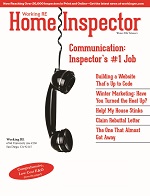 |
> E&O/GL Insurance for Home Inspectors Competitive Rates, Broad Coverage, Free Risk Management, online inspection support for tough questions, discounts on education and more… Professional Coverage, Competitive Pricing Shop OREP today! |
Editor’s Note: This story appears in Working RE Home Inspector’s January Print Edition. OREP insureds enjoy it free along with many other business and risk management benefits! WRE reaches 20,000+ Home Inspectors in Print and Online!
Soot, Ghosts and Ugly Stains
By Tom Feiza, Mr. Fix-It, Inc.
Have you seen a ghost? In recent years, I have investigated numerous complaints of black or gray stains in homes. These may be geometrically shaped stains that outline exterior wall framing, dots at drywall fasteners, or dirt staining on carpeting along outside walls. The stains may create a ghost-like outline of the framing (the skeleton) of the home. What is this?
Black particles may also occur on television screens, appliances and countertops. I have even investigated a home in which stains appeared on walls, white carpeting under doors and a pure white miniature poodle. Why does staining occur in our homes? What has changed to cause these problems? (See Figure 1: Ghost Stains on Walls, Ceiling.)
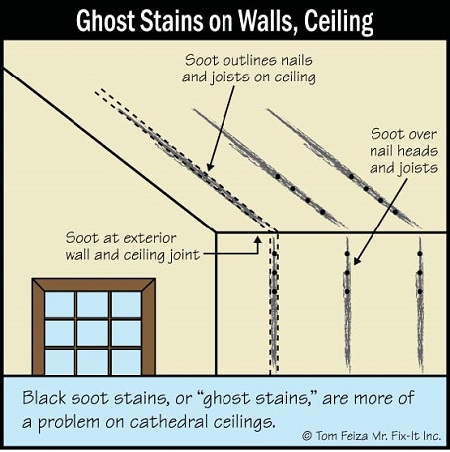
Figure 1: Ghost Stains on Walls, Ceiling
Dark stains or “ghost stains” are difficult to investigate. We need to determine the source of the dark material and its relationship to the pattern of staining. Usually we discover two problems: soot production and delivery of the soot to the surface. The location and shape of the stain can give us a few clues. And don’t worry—the stains usually are not mold.
Mold?
First, let’s discuss the mold question. With the scary media coverage of mold, any black, green or gold mark is a suspected mold growth, but most dark ghost stains, carpet stains or deposits on plastic surfaces are caused by soot or carbon, not mold.
Ghost stains? Soot stains
The dark stains that outline wood framing or drywall fastener heads are often called ghost stains because they appear as ghostly images of the framing or fasteners. Ghost stains may also appear on room or stairway carpeting, on plastic, around pictures or below doors.
Most ghost stains are related to soot or small black particles that deposit on surfaces through several mechanisms. They are difficult to remove because they consist of very fine dirt particles or an oily and/or carbon-based deposit from incomplete combustion.
Are stains more common today?
Years ago, when homes were heated with a fire and lit with oil lamps or candles, soot was just accepted. A common chore was cleaning the soot from clear glass lamp mantels. Today we maintain very clean homes with many white surfaces, and even a small dark stain is easy to identify.
We also have forced-air heating systems and numerous fans and combustion devices that move air in the home. If systems aren’t perfectly installed—and they are never perfect—air flow will move particles and deposit stains in remote locations. Many homes can suck air and particles from the outside and through carpeting, doors or even walls. The carpet becomes a filter that traps dirt and soot.
We love our electronics and plastic. Electronic devices can create a charge that attracts particles. Plastics may have an electrostatic charge that also attracts particles. Many electronic devices move air through their framework for cooling—again, moving and depositing particles.
Finally, today we are pickier homeowners. We expect our homes to be clean and to stay clean. We don’t accept stains in our homes.
Where do the dark particles come from?
There are many possible sources inside and outside your home for these dark spots. The exact source can be difficult to identify, and often you must work from the most obvious to the remote possibilities. Common sources of particles are:
• Candles—the big offender. Candles that are scented or in jugs often create more soot than standard candles because of incomplete combustion. Candles with long, untrimmed wicks can also produce more soot. (See Figure 2: Candle: Soot Generator.)
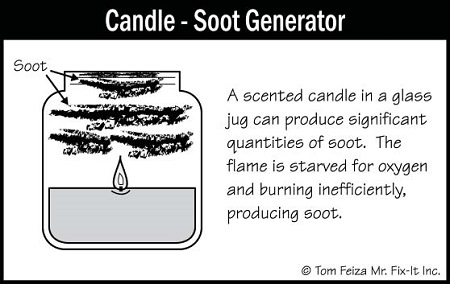
Figure 2: Candle: Soot Generator
• Oil lamps—these create the same problems as candles. Just look at the glass mantle. Burning incense belongs in this group, too.
• Combustion appliances—any device that burns solid fuel, oil or gas is a potential source. Incomplete combustion creates particles. Appliances that are not vented properly can deposit products of combustion and particles in a home; a wood-burning fireplace is an obvious source.
• Gas fireplaces—that nice, lazy yellow flame looks good but can also produce particles. If the combustion were more complete, the flame would be closer to a solid blue color, not a soft yellow.
• Gas pilot lights—poor adjustment can produce soot. A pilot light that strikes or “impinges” on a surface may also produce incomplete combustion and soot.
• Smoking—a possible cause in excessive cases, but often these smoke particles are tan or yellow until they pick up common dirt.
• Internal combustion engines—cars, lawnmowers, diesel engines. If your home has poor air balance, these particles can be sucked indoors from the attached garage or from outside.
• Construction-related dirt and dust—drywall-sanding dust or concrete-cutting dust are two sources.
• Deteriorating carpet, drapes and cloth can produce sooty stains.
• Dirt—from soil, pets, kids and animals.
• Cooking—what have you burned lately? Does your kitchen fan really exhaust cooking odors and smoke to the outdoors or just recirculate it inside your home?
• Dust-producing activities—these include woodworking, furniture refinishing, welding, cutting metal with flame, and grinding.
• A vacuum cleaner—if your vacuum has a poor filtering and capture system, it may spread dirt and soot in your home.
Why the ghost-like deposits?
Soot and carbon particles are very small and light. They move easily and can remain suspended in the air for many hours.
These particles will also be distributed by your forced-air heating or cooling system and most vacuum cleaners.
Several scientific principles describe the action of particles depositing on surfaces.
• Changes in air flow: When air changes direction, particles can drop out of the air. Where air flows beneath doors, for example, the particles drop into the carpet. (See Figure 3: Soot Deposits at Doorway.)
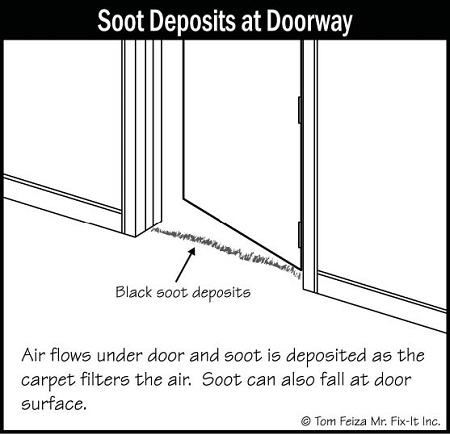
Figure 3: Soot Deposits at Doorway
• Filtration: When air moves through carpeting, the carpet acts as a filter and traps dirt particles. In a home that has an improperly operating forced-air system, you may see filtration stains at the exterior baseboard where air is being sucked into the home. You may see stains on carpeted stairs since air is sucked through the stairs into the return of the air handler in the basement. (See Figure 4: Soot Stains at Carpet / Walls.)
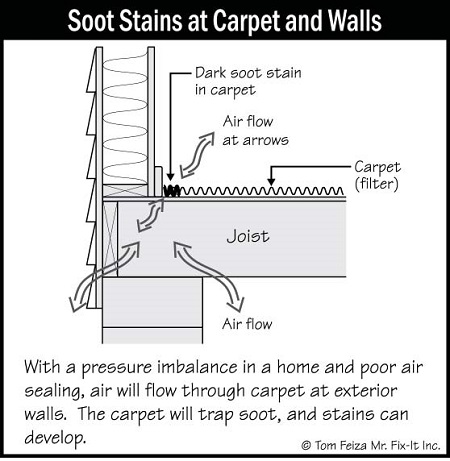
Figure 4: Soot Stains at Carpet / Walls
• Surface Temperature Changes: Air has a certain amount of energy that varies with temperature. At a higher temperature, particles in the air move quickly; at a lower temperature, particle movement slows. When air that contains soot particles moves across a cooler surface, the soot particles slow and can be deposited on the cooler surface. This action is what causes the ghost stains that outline framing and drywall fasteners; there is less insulation at the wood studs, so the surface is cooler, and the soot deposits on the cooler surface. (See Figure 5: Ghost Stains on Exterior Walls.)
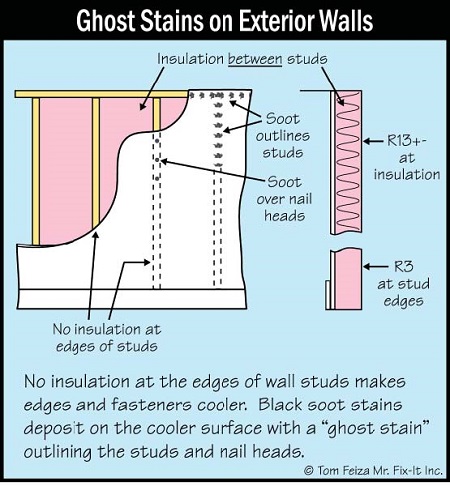
Figure 5: Ghost Stains on Exterior Walls
• Increased Air Flow: Warmer air rises, and forced-air systems push, pull and move air. The air flow can cause visible deposits on and above heating grills, above radiation equipment, and above light bulbs adjacent to walls. Some of the deposits are also caused by the convective flow of dirty air in the room. (See Figure 6: Soot Stains at Light Fixture.)
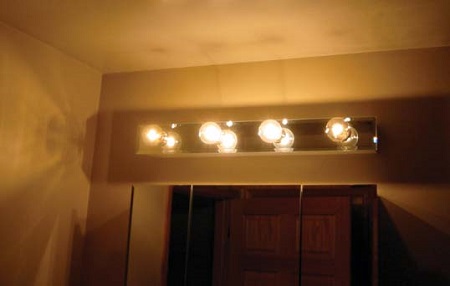
Figure 6: Soot Stains at Light Fixture
• Electrostatic Charge: Electronic air filters and smoke filters use electrostatic charges to filter air. The same electronic-charge principles attract particles to the TV screen, some plastics, electronic equipment and appliances. Movement of air through the ductwork in your home can also charge particles in the air and make them stick to surfaces.
• Gravity: Eventually, particles and debris will drop out of the air. They often create deposits on flat surfaces such as countertops.
What can a homeowner do?
Start by understanding the sources of soot and dirt particles. Consider the process that may be depositing the soot on surfaces in your home. Then eliminate the obvious sources and watch for future stains. Be particularly wary of scented candles, candles in jugs, oil lamps and gas fireplaces.
If you must use candles, use high quality candles and burn them in an open area—not in a partially closed container. Keep the candlewick trimmed to one quarter inch or less for better combustion and a cleaner burn with less soot.
Have all your combustion appliances serviced by professionals on a routine basis—a good practice with or without soot problems. Specifically ask the contractor to check the combustion gas venting and test for backdrafting of combustion gas.
Unfortunately, there are few resources and a limited number of experienced consultants who understand the soot and ghost stain problem. If your home has a particularly bad problem, with strange deposits outlining walls or strange patterns in carpeting, it’s probably due to an air imbalance in your home combined with a soot production problem. This type of air flow problem could be investigated by a consultant who specializes in home performance and has training in measuring air flow and pressure differentials. Your home should be evaluated as a complicated set of interrelated systems moving air and creating differential pressures.
It appears that most ghosting problems are not directly related to construction. Problems are often related to increased production of soot, more light-colored surfaces in our homes, and higher expectations of homeowners. Increased use of candles certainly has had a big impact on increasing the soot and ghosting stain problem.
About the Author
Tom Feiza has been a professional home inspector since 1992 and has a degree in engineering. Through HowToOperateYourHome.com, he provides high-quality marketing materials that help professional home inspectors boost their business. Visit HowToOperateYourHome.com (or htoyh.com) for more information about building science, books, articles, marketing, and illustrations for home inspectors. Or contact Tom with questions or comments at Tom@misterfix-it.com or 262-303-4884.
Free Risk Management Online Course
Claims and Complaints: How to Stay Out of Trouble
Available Now
Presenter: David Brauner, Senior Insurance Broker OREP
David Brauner, Senior Broker at OREP, shares insights and advice gained over 25+ years of providing E&O insurance for inspectors, showing you how to protect yourself and your business. Watch Now!
Note: The January 2018 issue of Working RE Inspector mailed to over 20,000 home inspectors nationwide. OREP Insureds enjoy guaranteed delivery of each print magazine and many more benefits.



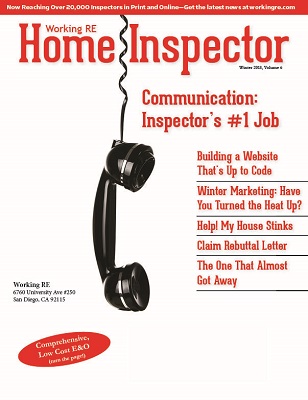
by Nicola
I’ve noticed in one bedroom which is the spare room of my home green, grey, brown stains on the carpet in this room. They look like an outline of circles, that follow almost like in a path. I’ve never seen this before, and these stains aren’t anywhere else in the house. Yes our house is damp especially at that end of the house, but I’ve lived here for 16 years and have never seen these stains before. Which makes me question is there something in my home? Because we have seen images of ghosts in our home recently my daughter saw a very tall dark figure in the corner of her room. Two weeks ago. We’ve seen this figure in our house before 2019. And performed a cleansing ceremony using white sage. Perhaps it never left at all.
-I have tried using carpet cleaning products to try and remove these stains it doesn’t seem to work. If anyone has any suggestions on how I could remove these stains and explain what these stains are please let me know. Thanks
by nike dunk low premium sb qs crawfish heren
asics gel lyte iii ronnie fieg total eclipse uomonike air jordan original 5 v fire reds white red black 23 femmechaussures puma suede classic vintage khakinike metcon moda casual
-nike dunk low premium sb qs crawfish heren [url=http://www.swasticnation.com/verkoop/nike-dunk-low-premium-sb-qs-crawfish-heren]nike dunk low premium sb qs crawfish heren[/url]
by Joseph M. Franks
Great Article.. I come about this “ghosting” condition periodically – A knowledgeable Inspector can impress his Clients..!
-